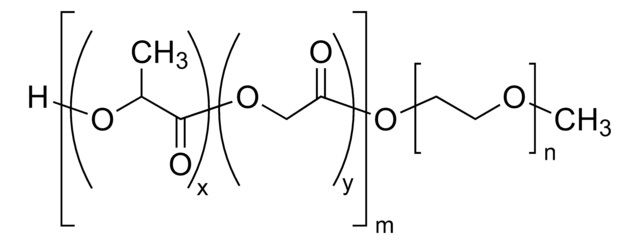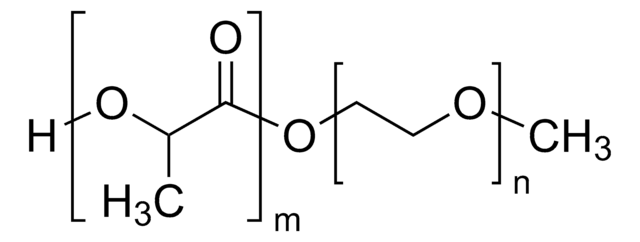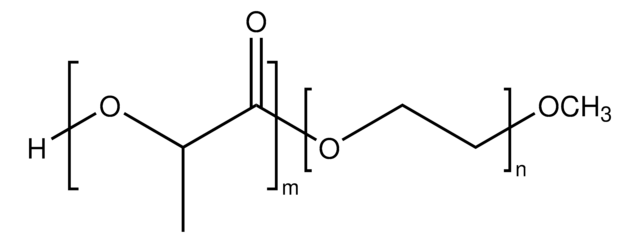799041
Poly(ethylene glycol) methyl ether-block-poly(L-lactide-co-glycolide)
PEG average Mn 5,000, PLGA average Mn 25,000, lactide:glycolide 50:50
Synonym(s):
PEG-PLGA, PEG-b-PLGA
Sign Into View Organizational & Contract Pricing
All Photos(2)
About This Item
Linear Formula:
CH3[C2H4O]nO[(C2H2O2)x(C3H4O2)y]mH
UNSPSC Code:
12162002
NACRES:
NA.23
Recommended Products
form
powder
Quality Level
mol wt
PEG average Mn 5,000
PLGA average Mn 25,000
composition
lactide:glycolide 50:50
storage temp.
2-8°C
Related Categories
Application
Amphiphilic block copolymers (AmBC) are made up of two chemically different homopolymer blocks. One of the block is hydrophilic and the other one is hydrophobic. These macromolecules have the properties to self-assemble when dissolved in an aqueous media. PEG-PLGA is one the most commonly used biodegradable amphiphilic block copolymers for drug delivery applications. PEG is the hydrophilic part and PLGA is the hydrophobic part.Used in the synthesis of targeted nanoparticles which are used for differential delivery and controlled release of drugs
Features and Benefits
- Good biocompatibility, low immunogenicity and good degradability.
- Properties can be easily modulated by changing the block copolymer segment sizes to suit a particular application.
Storage Class
11 - Combustible Solids
wgk_germany
WGK 3
flash_point_f
Not applicable
flash_point_c
Not applicable
Choose from one of the most recent versions:
Certificates of Analysis (COA)
Lot/Batch Number
Don't see the Right Version?
If you require a particular version, you can look up a specific certificate by the Lot or Batch number.
Already Own This Product?
Find documentation for the products that you have recently purchased in the Document Library.
Customers Also Viewed
Articles
The development of drugs that target specific locations within the human body remains one of the greatest challenges in biomedicine today.
Global Trade Item Number
| SKU | GTIN |
|---|---|
| 799041-1G | 4061826140352 |
Our team of scientists has experience in all areas of research including Life Science, Material Science, Chemical Synthesis, Chromatography, Analytical and many others.
Contact Technical Service






